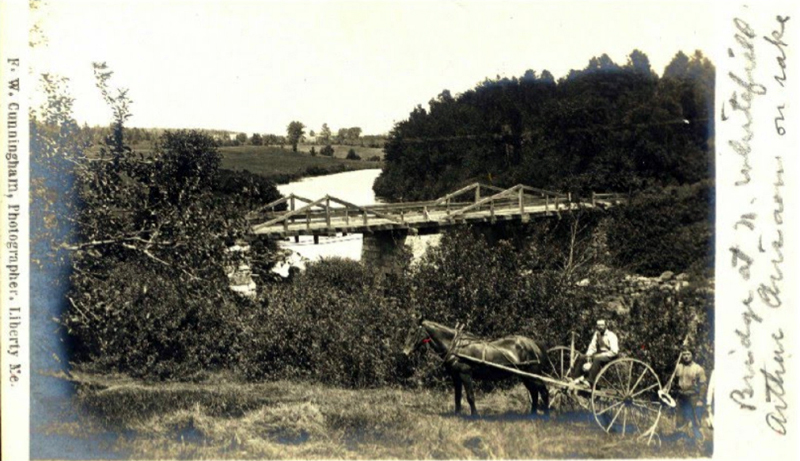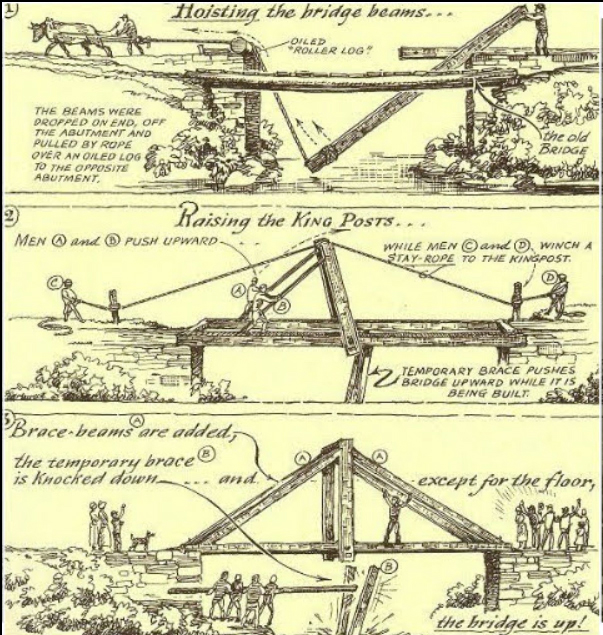
An F.W. Cunningham photo of a bridge at North Whitefield from David Chase’s “Bridges of Whitefield, Maine” album.
This bridge will only take you halfway there
To those mysterious lands you long to see:
Through gypsy camps and swirling Arab fairs
And moonlit woods where unicorns run free.
So come and walk awhile with me and share
The twisting trails and wondrous worlds I’ve known.
But this bridge will only take you halfway there —
The last few steps you’ll have to take alone.
— “The Bridge” by Shel Silverstein
It’s hard to drive through Whitefield without driving over a bridge. Each time I drive over one I am grateful for its existence. Driving over bridges brings us to different parts of our community. Each one a little different and unique in its own way. The bridge acts as a connection. When it comes to bridges and connections, I can speak for myself and say that I am grateful for both, especially during this year’s long winter months.
While feeling like a long winter, this winter has been a relatively mild one. Snowfall has been minimal, temperatures bearable, and some folks have even been able to enjoy late January ice skating on fairly clear ponds. Thankfully, thoughts of ice jams are still weeks away from our daily concerns.

A drawing from David Chase’s “Bridges of Whitefield, Maine” album shows the construction of a bridge.
Because I enjoy history, I was searching through historical information on Whitefield and I came across a historic photo of a North Whitefield bridge from days of yesteryear. I also uncovered a newspaper clipping from 1875, almost 150 years ago. The article discussed the spring freshets, “a spring thaw resulting from snow and ice melt,” and the damage they did to Whitefield bridges that year.
According to this April 16, 1875 news clip, “Two miles south of Coopers Mills … the bridge on the western branch of the Sheepscott known as the Nothly Bridge was badly damaged, the western half with the pier was carried away. Farther down the river at Partridges Mill, the ice 2 1/2-3 feet thick, jammed some distance above the bridge, endangering both mills and bridge, but fortunately the ice passed down gradually, doing no harm at this place save slightly injuring two of the bridge piers.
“Two and a half miles below, at the town-house bridge, the damage was heaviest. The eastern section of this bridge, together with the heavy abutment, was totally demolished. The Sheepscott has not been this high since 1839. Many bridges in town on the smaller streams were carried away to the great annoyance of travelers. Indeed, these spring freshets, with their maddened torrents dashing onto the sea, their path marked by destruction on every hand, are unwelcome visitors.”
As I read that, I found myself thinking of the symbolism of this devastation and rebuilding that took place. Because the community came together, the bridges were repaired and rebuilt. Connections saved. Everyone I speak with, whether it be at the post office or at a local market, says how divided our country feels right now. While this column is not about nor will it be about politics, this division is hard to ignore, even in our community.
Like the power of the bridges that have serviced our town for well over 200 years, it has become clear that we each need to reach out and find what unifies us. This symbolism of bridges and connection is obvious. Thankfully, with connection comes hope and understanding.
Reach out to your neighbors. Make sure everyone is OK. Offer help if needed. But I know that most reading this column already do that. That’s what makes Whitefield such a special town to live in.
The news item and photos in this column are from “The Bridges of Whitefield, Maine,” compiled by David Chase and available at tinyurl.com/46fk9r1c.
Mary Dunn
Whitefield Correspondent
(Send your updates and/or information you’d like included in this column to me at the email address above. Include “Whitefield” in the subject line.)



